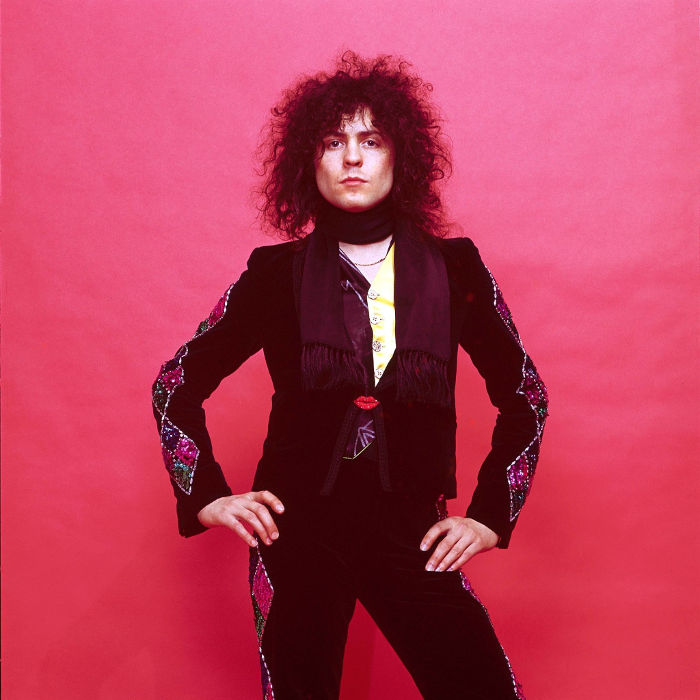Members
1 Male
Origin
 Hackney, East London
Hackney, East London
Genre
 Folk
Folk
Style
---
Mood
---
Born
1 Male
Origin
Genre
Style
---
Mood
---
Born
4 users
3 users
3 users
Artist Biography
Available in:
Marc Bolan (born Mark Feld; 30 September 1947 – 16 September 1977) was an English singer-songwriter, musician, guitarist, and poet. He was best known as the lead singer of the glam rock band T. Rex. Bolan was one of the pioneers of the glam rock movement of the 1970s. He died at the age of 29 in a car crash a fortnight before his 30th birthday. In 1997, a memorial stone and bust of Bolan, Marc Bolan's Rock Shrine, was unveiled at the site where he died in Barnes, London.
Bolan’s appearance on the BBC's music show Top of the Pops in March 1971, wearing glitter and satins, is often cited as the beginning of the glam rock movement. Music critic Ken Barnes called Bolan "the man who started it all". T. Rex’s 1971 album Electric Warrior, with all songs written by Bolan, including the UK chart topper “Get It On”, has been described by AllMusic as “the album that essentially kick-started the UK glam rock craze.” Producer Tony Visconti, who would also work with the other major glam rock pioneer David Bowie, stated, “What I saw in Marc Bolan had nothing to do with strings, or very high standards of artistry; what I saw in him was raw talent. I saw genius. I saw a potential rock star in Marc – right from the minute, the hour I met him.”
Bolan was born at Hackney Hospital and grew up in Stoke Newington, in the borough of Hackney, east London, the son of Phyllis Winifred (née Atkins) and Simeon Feld, a lorry driver. His father was an Ashkenazi Jew of Russian and Polish ancestry, while his mother was of English, Welsh and Scottish descent. Moving to Wimbledon, southwest London, he fell in love with the rock and roll of Gene Vincent, Eddie Cochran, Arthur Crudup and Chuck Berry and hung around coffee bars such as the 2i's in Soho.
Bolan was a pupil at Northwold Primary School, Upper Clapton. He appeared as an extra in an episode of the television show Orlando, dressed as a mod. At the age of nine, he was given his first guitar and began a skiffle band. While at school, he played guitar in "Susie and the Hula Hoops," a trio whose vocalist was a 12-year-old Helen Shapiro. During lunch breaks at school, he would play his guitar in the playground to a small audience of friends. At 15, he was expelled from school for bad behaviour.
Bolan briefly joined a modelling agency and became a "John Temple Boy", appearing in a clothing catalogue for the menswear store. He was a model for the suits in their catalogues as well as for cardboard cut-outs to be displayed in shop windows. Town magazine featured him as an early example of the mod movement in a photo spread with two other models. In 1964, Bolan met his first manager, Geoffrey Delaroy-Hall, and recorded a slick commercial track backed by session musicians called "All at Once" (a song very much in the style of his youthful hero, Cliff Richard, the "English Elvis"), which was later released posthumously by Danielz and Caron Willans in 2008 as a very limited edition seven-inch vinyl after the original tape recording was passed onto them by Delaroy-Hall. This track is one of Bolan's first professional recordings.
Bolan then changed his stage name to Toby Tyler when he met and moved in with child actor Allan Warren, who became his second manager. This encounter afforded Bolan a lifeline to the heart of show business, as Warren saw Bolan's potential while he spent hours sitting cross-legged on Warren's floor playing his acoustic guitar. Bolan at this time liked to appear in boho-chic, wearing a corduroy peaked cap similar to his then current source of inspiration, Bob Dylan. A series of photographs was commissioned with photographer Michael McGrath, although he recalls that Bolan "left no impression" on him at the time. Warren also hired a recording studio and had Bolan's first acetates cut. Two tracks were later released, the Bob Dylan song "Blowin' in the Wind" and Dion Di Mucci's "The Road I'm On (Gloria)". A version of Betty Everett's "You're No Good" (still unreleased) was later submitted to EMI for a test screening but was turned down.
Warren later sold Bolan's contract and recordings for £200 to his landlord, property mogul David Kirch, in lieu of three months' back rent, but Kirch was too busy with his property empire to do anything for him. A year or so later, Bolan's mother pushed into Kirch's office and shouted at him that he had done nothing for her son. She demanded he tear up the contract and he willingly complied. The tapes of the first two tracks produced during the Toby Tyler recording session vanished for over 25 years before resurfacing in 1991 and selling for nearly $8,000. Their eventual release on CD in 1993 made available some of the earliest of Bolan's known recordings.
He signed to Decca Records in August 1965. At this point his name changed to Marc Bolan via Marc Bowland. There are several accounts of why Bolan was chosen, including that it was derived from James Bolam, a contraction of Bob Dylan, and - according to Bolan himself, that Decca Records chose the name. He recorded his debut single "The Wizard" with The Ladybirds on backing vocals (later finding fame with Benny Hill), and studio session musicians playing all the instruments. "The Wizard", Bolan's first single, was released on 19 November 1965. It featured Jimmy Page and Big Jim Sullivan, was produced by Jim Economides, with music director Mike Leander. Two solo acoustic demos recorded shortly afterwards by the same team ("Reality" and "Song For A Soldier") have still only been given a limited official release in 2015 on seven-inch vinyl. Both songs are in a folk style reminiscent of Dylan and Donovan. A third song, "That's the Bag I'm In," written by New York folk singer and Dylan contemporary Fred Neil, was also committed to tape, but has not yet been released. In June 1966, a second official single was also released, with session-musician accompaniment, "The Third Degree", backed by "San Francisco Poet", Bolan's paean to the beat poets. Neither song made the charts.
In 1966, Bolan turned up at Simon Napier-Bell's front door with his guitar and proclaimed that he was going to be a big star and he needed someone to make all of the arrangements. Napier-Bell invited Bolan in and listened to his songs. A recording session was immediately booked and the songs were very simply recorded (most of them were not actually released until 1974, on the album The Beginning of Doves). Only "Hippy Gumbo", a sinister-sounding, baroque folk-song, was released at the time as Bolan's third unsuccessful single. One song, "You Scare Me to Death," was used in a toothpaste advertisement. Some of the songs also resurfaced in 1982, with additional instrumentation added, on the album You Scare Me to Death. Napier-Bell managed The Yardbirds and John's Children and was at first going to slot Bolan into the Yardbirds. In early 1967 he eventually settled instead for John's Children because they needed a songwriter and he admired Bolan's writing ability. The band achieved some success as a live act but sold few records. A John's Children single written by Bolan called "Desdemona" was banned by the BBC for its line "lift up your skirt and fly".
His tenure with the band was brief. When the band split following an ill-fated German gig with The Who, Bolan took some time to reassess his situation. Bolan's imagination was filled with new ideas and he began to write fantasy novels (The Krakenmist and Pictures Of Purple People) as well as poems and songs, sometimes finding it hard to separate facts from his own elaborate myth - he famously claimed to have spent time with a wizard in Paris who gave him secret knowledge and could levitate. The time spent with him was often alluded to but remained "mythical". In reality the wizard was probably American actor Riggs O'Hara with whom Bolan made a trip to Paris in 1965. Given time to reinvent himself, after John's Children, Bolan's songwriting took off and he began writing many of the poetic and neo-romantic songs that would appear on his first albums with T. Rex.
Wide Thumb
Clearart

Fanart

Banner

User Comments
 No comments yet..
No comments yet..


